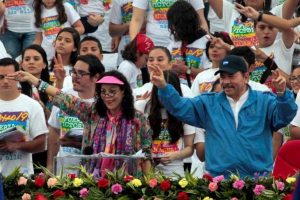 The summer between my junior and senior year of high school I lived in a small community in rural Nicaragua. In July my host mother hung a FSLN—Sandinista National Liberation Front—flag outside my home. It was very exciting. I was living with a real socialist!
The summer between my junior and senior year of high school I lived in a small community in rural Nicaragua. In July my host mother hung a FSLN—Sandinista National Liberation Front—flag outside my home. It was very exciting. I was living with a real socialist!
Before going to Nicaragua I had done my research. I am a history major now and even in high school I was very interested in American intervention and Latin America’s long struggle for independence. I therefore knew about Augusto Sandino, the Sandinista’s overthrow of the Somoza dictatorship, Reagan and the contra war, Oliver North and the Iran-Contra scandal. I understood—to some extent—the history and significance behind that flag.
July 19th is Sandinista/Nicaragua Liberation Day, similar to America’s Fourth of July except politicized. In preparation people throughout my community hung FSLN flags on their property. My host-siblings invited Kelly (the other American living in the community) and I to go with them on July 19th to Managua to celebrate. I was fascinated. What does a socialist revolution day look like? Especially considering that their revolution is within living memory for many Nicaraguans. Unfortunately, we did not get permission from Amigos de las Américas—the non-profit we went to Nicaragua with—to leave our community and go to Managua. Their decision was understandable. They would take on a tremendous amount of risk if they allowed two sixteen year old girls to takeoff for the capital on the most hectic day of the year. Everyone on the program (we were spread out amongst different communities in the region) was told to stay home. While every Nicaraguan I met had been extremely welcoming to us as Americans up until that point, there was concern that on the anniversary of the Sandinista revolution anti-American sentiment might emerge.
My older host-siblings got up very early on July 19th to catch a bus to Managua. It felt like every single young person in Nicaragua was streaming towards the capital. On the television we watches buses and buses of rowdy Nicaraguans dressed in red and waving FSLN flags. In Managua there were plazas overflowing with people shouting and cheering. In the United States Fourth of July celebrations are localized. Maybe a town parade, family barbecue, fireworks at the baseball field. Not so in Nicaragua. Managua was the pulsing heart of the country, the center of everyone’s attention, the beacon of socialist aspirations. If there were Nicaraguans opposed to the Sandinistas I did not see them or hear them. On the television screen it seemed that the whole country was united in their exuberance and pride. Nicaraguan identity was Sandinista identity.
I watched as Daniel Ortega and Rosario Murillo addressed the crowds. This was their day. As a revolutionary in war and political leader in peace, Ortega, more than anyone, is the Sandinista Party. An almost mythical figure from the past who still graces the present with his wisdom and experience. On July 19th the crowds were roaring to honor him.
My ‘About Nicaragua’ page will provide historical context for the July 19th holiday and examine how it is practiced today. I could find very little to no information on Nicaragua Liberation Day from American/English sources. If I had not been to Nicaragua over the summer I would never know that it existed. Nicaragua faded from American national consciousness after the contra war. While there is a plethora of research on the revolution, what happened next is forgotten and an anniversary celebrating the once-important socialist uprising is entirely overlooked. My sources on how it is currently practiced are thus primarily Spanish-language/Latino newspapers documenting the festivities.

